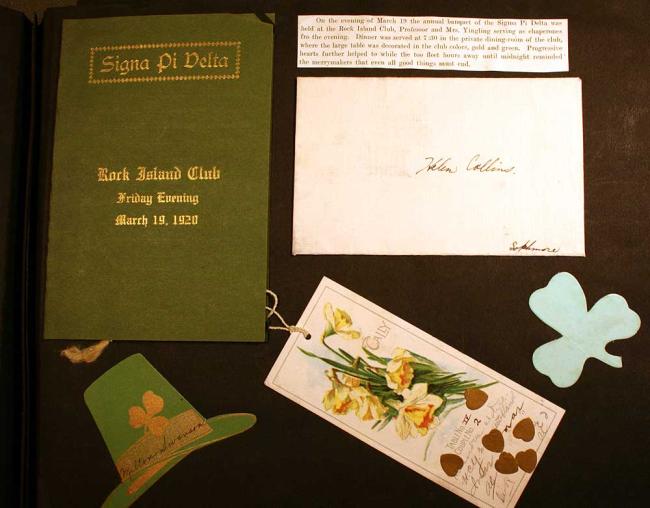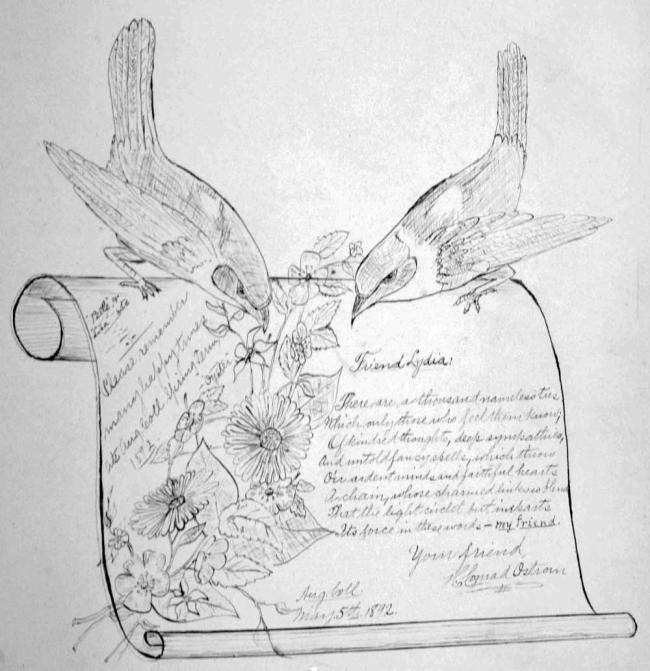Scrapbooks and social networking of the past

(This story was written in celebration of Augustana's sesquicentennial in 2010.)
"Our lives are albums written through
With good or ill - with false or true -
And as the blessed angels turn,
The pages of our years,
God grant they read the good with smiles
And blot the bad with tears."
— Your true friend and school-mate, Mary Sjostrom
Have you ever stopped to wonder how people recorded activities, messaged friends, posted pictures, and shared memories before Facebook? Turns out that early social communication wasn't so different than the online networking we have today — except, of course, that it wasn't online.
In the past, students and alumni of the college kept detailed scrapbooks of their years at, and beyond, Augustana. These albums featured quotes and signatures from friends, artwork, samples of beautiful penmanship, postcards, newspaper clippings, tickets stubs, invitations, even pressed flowers. Like today's Facebook, students used their books to log friends' birthdays and weddings, comment on one another's activities, and share and preserve photographs. Their books were visual representations of their lives, glimpses into what they cherished.

There are a number of these scrapbooks available for viewing in Special Collections. An album belonging to Lydia Olsson (daughter of Olof Olsson, third president of Augustana College) is simply labeled "Autographs," but inside you'll find more than signatures. (The poem above comes from Lydia's scrapbook.)
There's also "My Memory Book" by Helen Collins, an Augustana student circa 1922. Collins' book has many paper objects from her time at the college: dance cards, valentines, her place setting at dinner events, pamphlets of rules and regulations, menus of meals she attended, and lots of goofy pictures of friends.
Netta Bartholomew Anderson, one of the first women admitted to Augustana, created a sketchbook of images from Berlin, Germany.
Not all of the albums were made by students. Olof Nelson, who emigrated from Sweden in 1882 and became an ordained Lutheran minister in 1899, kept a scrapbook he called "Flora of the U.S. and Europe." He collected 100 samples of dried flowers and copied a literary quote about flowers onto each page. For example: "The flower that smiles today / Tomorrow dies / All that we wish to stay / Tempts and then flies" (Shelley). Nelson went on to have a vineyard and raisin farm in California. (Ever heard of Sun-Maid?)

Like Helen Collins, Susanne Denkmann collected many physical items from her time at Dana Hall School and Wellesley College in her book, including a dried corsage and a ripped glove. She even preserved a note left on her door inviting her to a party: "Thanksgiving Eve in Room No. 1, Nov. 23, 1892."
Paging through these scrapbooks is an intense, bittersweet experience. Overflowing with social artifacts, the dusty, brittle pages testify: These were real people with interests and passions, dreams and ambitions. They loved and were loved. Friendship, travel, education, family; their lives were not so very different from our own.
How, then, will we be remembered? Will future generations plumb our electronic "memory books" and digital photo collections? Will they pore over our "status updates" and instant message exchanges? Will we leave anything for them to touch?
— Amanda Makula
Reference Librarian
